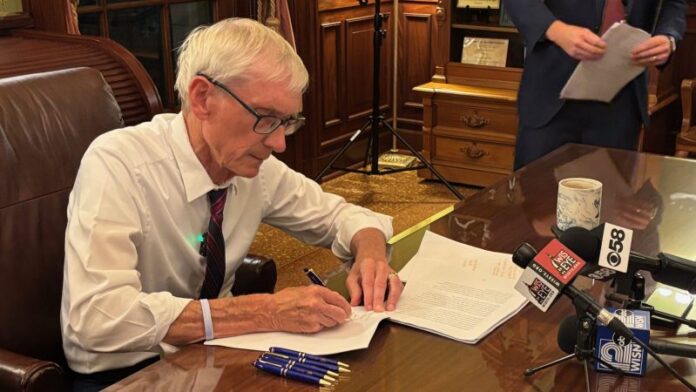Gov. Tony Evers early this morning signed a $111.1 billion budget less than an hour after it cleared the full Legislature as he and lawmakers raced to complete the document before Congress signed off on the reconciliation bill.
That’s because a provision in that federal bill would block a plan in the state budget to increase a hospital assessment to generate additional federal revenue that would then largely be sent back to hospitals.
In the process, Evers signed a document that cut taxes deeper than he had proposed while pumping more money into education and child care than Republicans wanted.
As he signed the documents about 1:30 a.m., Evers told reporters it was a story of compromise.
>> WisPolitics is now on the State Affairs network. Get custom keyword notifications, bill tracking and all WisPolitics content. Get the app or access via desktop.
“I think it’s a reflection of the fair maps,” Evers said. “We’re a purple state. We’re going to be a purple state, I’m guessing for a long time, so we need to work together.”
For much of Evers’ time in office, GOP lawmakers have rejected large swaths of his proposals before sending a budget back to him that he then reworked with his broad partial veto authority. While they struck deals two years ago on education and state aid to local governments, Republicans watched as Evers reworked the budget to nix the heart of an income tax cut GOP lawmakers had authored. The guv then used his partial veto authority to write into state law an annual increase of per-pupil spending for four centuries, pushing Republicans to file a lawsuit challenging the action, only to see the liberal majority on the state Supreme Court uphold the move.
But this time, the guv, GOP lawmakers and Senate Dems worked out an agreement covering K-12 education, the Universities of Wisconsin, transportation and taxes that make up the heart of the budget lawmakers approved.
It produced a mixed reception in both houses.
The bill cleared the Assembly 59-39, with several member breaking ranks. Rep. Scott Allen, R-Waukehsa, joined most Dems in voting against the budget. Meanwhile, seven Dems supported it: Jill Billings, of La Crosse; Steve Doyle, of Onalaska; Jodi Emerson, of Eau Claire; Tara Johnson, Town of Shelby; Maureen McCarville, of DeForest; Sylvia Ortiz-Velez, of Milwaukee; and Lori Palmieri, of Oshkosh.
In the Senate, four Senate Republicans voted against the budget: Rob Hutton, of Brookfield; Chris Kapenga, of Delafield; Steve Nass, of Whitewater; and Mary Felzkowski, a Tomahawk Republican who serves as the chamber president.
Felzkowski’s office, citing research conducted by the Legislative Reference Bureau, said it was the only time in state history a Senate president had voted against the budget.
Five Dems backed the spending plan, helping it clear the chamber: Kristin Dassler-Alfheim, of Appleton; Brad Pfaff, of Onalaska; Jeff Smith, of Brunswick; Jamie Wall, of Green Bay; and Minority Leader Dianne Hesselbein, a Middleton Dem who was part of negotiations with the guv and GOP lawmakers on key components.
Assembly Speaker Robin Vos, R-Rochester, said the budget probably would have looked different under a Republican governor, but “this is one that I am proud to say we can support.”
“And for all those that I have heard talk about how we want to do things on a bipartisan basis, we want to have Republicans and Democrats work together to find consensus, I assume, like in the state Senate where Democrats and Republicans are going to vote for the budget, we would have the same thing here in the Assembly if people are serious about saying we want to work together to find that answer.”
Still, there was bipartisan criticism of the bill.
Rep. Angelina Cruz, D-Racine, criticized Evers and legislative leaders’ budget agreement for not investing more in education.
“The bipartisan budget agreement left districts like Racine Unified with rising costs, frozen funding and impossible choices, bigger class sizes, fewer counselors, gutted programs,” said Cruz, president of the teachers union in the Racine Unified School District. “That’s not fiscal responsibility, it’s state-sanctioned neglect.
During debate in the Senate, Felzkowski said there was lots to like in the budget, including tax cuts and more money to reimburse costs of special education. But she couldn’t vote for the budget because it failed to address the cost of health care while adding a move that would result in an additional $1 billion a year for state hospitals.
Felzkowski said Wisconsin has the fifth-highest health care costs in the country, but those who put the budget together refused to include reforms such as price transparency. She accused the guv of “selling out to special interests” in refusing to include in the budget deal policies opposed by state hospitals.
“It is the silent tax on our constituents and our businesses,” Felzkowski said.
The $111.1 billion budget seeks to increase spending through state and federal funds by 12.4% over current law. Adding in spending through borrowing pushes the overall price tag to $114.3 billion.
Ahead of today’s floor period, Senate Majority Leader Devin LeMahieu, R-Oostburg, sought to downplay the spending increase, saying it was driven by a push to spend the bulk of the state’s $4.4 billion surplus from the 2023-25 biennium and additional federal money the budget would generate.
Looking only at general purpose revenue — the main source of state spending — appropriations would go up 7.7% over the biennium. LeMahieu argued that was in line with inflation.
According to the Legislative Fiscal Bureau, the budget would still leave the state with an $829.3 million gross balance in the general fund at the end of the biennium.
The deal Evers and lawmakers agreed to includes:
- A boost of more than $500 million to special education funding compared to current law. The state now reimburses 32.1% of those costs. The budget would take that to 45% by the second year. The budget also could cover 90% of expenses for high-cost special education students, who incur costs of $30,000 or more in a year.
- $331.6 million in new funding for child care. That includes $110 million in direct payments to child care providers that would be covered through interest earnings from COVID-19 funds the state had received from the federal government.
- A net increase of $239 million in state money for the Universities of Wisconsin after GOP lawmakers had been considering an $87 million cut compared to current law. The budget also calls for $840 million in capital projects across campuses. In exchange, Republicans won a provision to require faculty and staff to meet minimum teaching loads.
The tax cut included in the budget includes significant portions of what Evers vetoed two years ago. That includes expanding the amount of income covered by the state’s second-lowest tax bracket of 4.4%.
It now applies to adjusted gross incomes between $14,680 and $29,370 for individual filers and $19,580 to $39,150 for married joint filers. The budget would take that cap up to $50,480 for individuals and $67,300 for married joint filers. It would save Wisconsinites $643 million over the biennium.
Republicans also added an exclusion for the first $24,000 of retirement income for individual filers 67 and older and married couples where both spouses have reached that age. The break would reduce state revenues by $695 million over the biennium.
As part of the deal with Evers, lawmakers agreed to expand the state’s existing sales tax exemption on residential utility bills. The state’s 5% sales tax now doesn’t apply to those bills between November and April. The deal extends that to bills for May through October at savings of $178.7 million for residents.
Other tax reductions in the budget include a film tax credit, an exemption from the sales tax for information products used by insurance companies and an expansion of the exemption for adoption costs.
Evers and GOP lawmakers have negotiated off and on since late March on various pieces of the budget. But talks broke down two weeks ago as LeMahieu said his caucus was uncomfortable with the trajectory on spending.
But things got back on track last week, leading to a flurry of action to complete the document. Part of that was due to the reconciliation bill before Congress that would cut off a provision in the budget seeking to direct more money to hospitals.
Wisconsin currently has an assessment of 1.8% of hospital patient revenues. That money is then used to draw additional matching dollars from the federal government, with much of that going back to hospitals.
The deal lawmakers and Evers reached seeks to take that assessment to 6%, the maximum now allowed under federal law to draw matching funds.
The Evers administration estimates hospitals would see more than $1 billion more under the proposal. The state would retain 30% of the funds, which would go into Wisconsin’s Medicaid trust fund.
The bill that cleared the U.S. Senate includes a moratorium on new or increased provider taxes. It also would reduce existing provider taxes in states that have expanded Medicaid through the Affordable Care Act. Wisconsin hasn’t taken that step.
The House included different language in the bill it passed in May. It would bar states from establishing new provider taxes and would freeze the tax at existing rates.
President Donald Trump has said he wants the reconciliation bill on his desk by July 4.
The Senate added a 35-page amendment that lawmakers described as “technical.”
It includes $51.8 million in new spending in addition to policy changes such as a requirement that the UW Board of Regents produce an efficiency study that focuses on declining student enrollment. Under the provision, the study must address performance indicators such as faculty-to-student ratios with a goal of streamlining operations.
Other changes included:
- Specifying that the changes to the hospital assessment take effect July 1 rather than the publication date of the bill.
- Dropping language that sought to impose a similar minimum teaching requirement for tech colleges that the budget calls for with faculty in the UW System.
- Moving $53 million in state aid slated for the UW System and instead put it in the Joint Finance Committee’s supplemental appropriation for release to the university at a later date.
The state budget also includes a nearly $1.2 billion increase in transportation spending through all funds, which amounts to a 16.4% increase. That total includes a $565 million, one-time transfer from the general fund in the first year of the biennium as lawmakers looked to use some of the state’s surplus to pay for projects in cash rather than with bonding.
The transportation section of the budget also includes a series of fee increases such as driver’s licenses and license plates, along with provisions such as $38 million in new money for Milwaukee County to compensate it for the cost of policing expressways. It’s the only county charged with that task.






